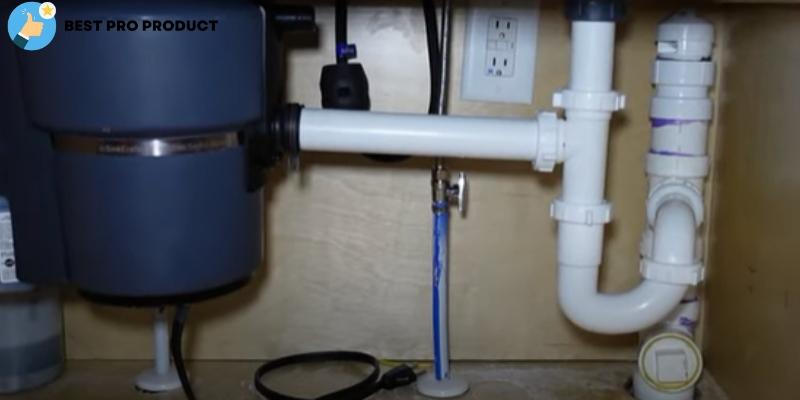I was standing near my garbage disposal, waiting for it to finish grinding the food, and started wondering, “Where does Garbage Disposal go?” This question has caught my attention as I’ve been using it for years and researching its environmental impact.
Garbage disposal waste takes three pathways before its final assortment to the landfills. The drainpipes transfer the waste directly to the wastewater treatment, but it’s not like putting a full stop to the story. The leftover food is filtered to produce energy, decomposes without oxygen, and is thrown into landfills.
In this article, I will mention most locations where you can assume the disposal waste would go. In addition, how it affects the environment is a must so you can consume less from the start.
Where Does a Garbage Disposal Drain?
Give a glance at the drainpipes that are attached to the disposal. Don’t you think about where they transfer the waste or just make its existence extinct? Since you are a disposal user, knowing how the internal and external parts work in food conversion nothing is unfamiliar. At the same time, water facility plants cannot handle all the gunk excreted by the disposal.
It is shuffled and divided into portions to hand over to the incinerators, anaerobic digesters, or landfills. However, knowing what food waste goes further to impact or benefit the environment is interesting.

Garbage Disposal Where Does it Go?
Predicting your presence here highlights the significance of your curiosity about what happens when the food is slid down from the main drainpipe to the water treatments. You may note the important points, whether it is recycled for drinking purposes or something else. The following three locations contribute to accepting food waste for a purpose.
Incinerator
You must hear about incinerators and their working. If not, these electrical furnaces work by burning food waste, and you can name these as waste to energy facilities. Apart from reducing the big portions of garbage from going into landfills, they produce gas as a by-product which is then used to produce heat and electricity.
However, naming the hazardous elements to be sent to the incinerators are, municipal solid waste and organic matter. At the same time, heat from the incinerator gives rise to hazardous pollutants like mercury, lead, and carbon dioxide, which can be life risks.
Anaerobic Digestion
Another destination to mention when discussing the journey of food waste is anaerobic digestion. The process works by aiding the help of bacteria residing in large tanks and allowing them to convert biosolids and food wastes into fuels without oxygen.
You may conclude, like mine, that anaerobic digestion is the most approachable way to treat waste before dumping it into landfills. One such advantage is that it does not produce methane or carbon dioxide to increase global warming.
Landfills
Garbage disposal aims to add the least possible amount of solid waste in landfills, for it distributes the various waste particles earlier to their designated home. Similarly, food waste without acceptance in incinerators or digesters is thrown into landfills.
Although you be happy cause landfills receive less waste, the problem has not ended yet. No matter how much trash goes in it, it produces methane gas and increases the earth’s temperature.
Is A Disposal Good for the Environment?
Looking through the broader side, disposal is beneficial in treating food waste. No matter how you treat the unit by dumping vegetable, fruit peels, bones, meat, or liquid particles, it designates various processing stages before adding to the landfills.
Garbage disposal seems appropriate and natural to treat your organic food waste after composting, as you do not randomly put it into the trash only to increase the landfill space. Moreover, the nitrogen in water harms marine life; think before you let it untreated.

Exploring Waste Management Options Beyond the Garbage Disposal
Exploring waste management alternatives that extend beyond traditional disposal is important for tackling the escalating environmental concerns of today’s world. Although garbage disposals provide comfort, they also impose added pressure on sewage systems and hinder effective recycling efforts.
If you’re prepared to swap out the blades and grinding chamber for a more environmentally friendly disposal system, these 5 options are for you.

What is the Most Environmentally Friendly to Dispose Waste?
If you know the most environmentally friendly way to dispose of food waste, consider composting. The process in which you compile your organic matter and decompose it to convert it to soil-rich fertilizers.
Do Garbage Disposals Need to be Emptied?
Emptying the disposal is as necessary as filling it to grind food into fine chunks. If you do so, no food particles will subside into the disposal chamber and cause blockage in the drains.
Summing Up
Estimating ideas about what happens to the food scraps when disposed of from the disposal is crucial. In this article, I have mentioned the results of my research that emphasizes the dissolved food goes into local water plants and then to the various energy-consuming or producing locations to harm or benefit the environment.

Asad is a garbage disposal enthusiast, mechanical engineer by education, and the visionary founder of Best Pro Product. Asad’s journey has seamlessly blended his engineering acumen with his passion for kitchen gadgets, leading to the creation of a go-to online platform for homeowners and DIY enthusiasts seeking expert guidance on garbage disposals. His meticulous research, hands-on testing, and insightful reviews have established him as a trusted authority, while his commitment to sustainability resonates through his advocacy for proper waste disposal and reduced food waste. Asad’s interactive engagement with his community and his penchant for experimenting with new recipes make him not just an online resource but a friendly companion for those navigating the world of kitchen appliances and eco-friendly living.
